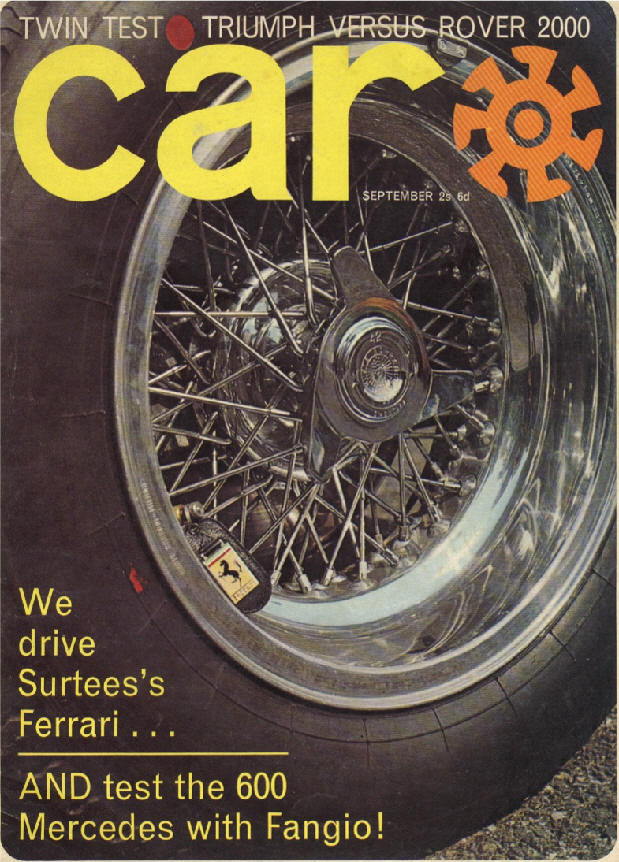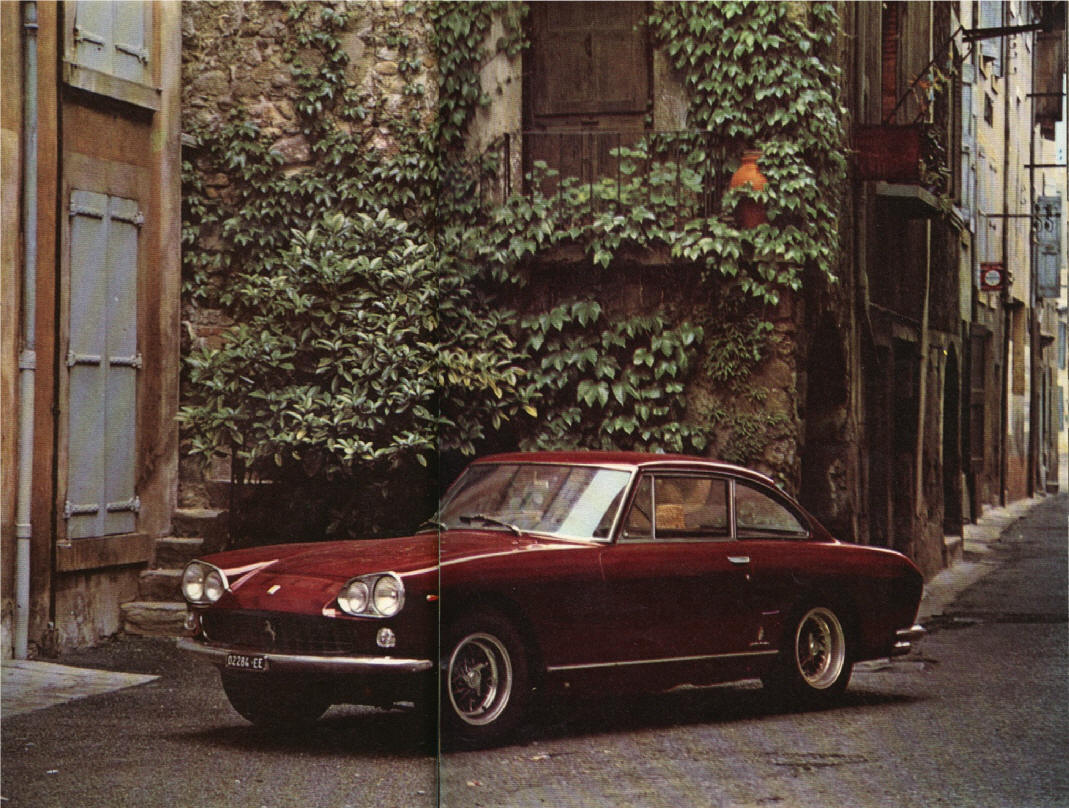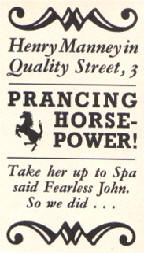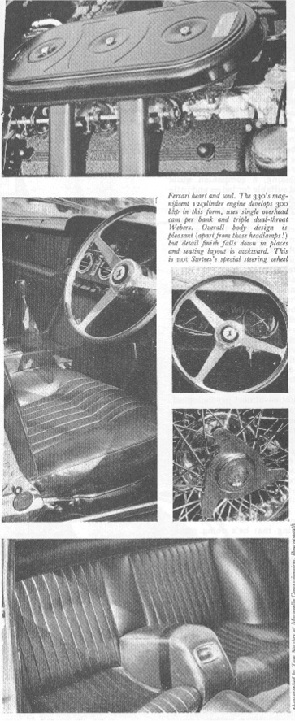 | 330 GT Registry |  |


 It ain’t very often that we get our hands on a Ferrari — in fact, if it was up to Ferrari the motoring press would hardly get a smell of one of the legendary 12 cylinder beasties. This state of affairs has come to pass because the marque really sells itself by means of its traditional mystique gained by numerous competition victories, and so the crafty Enzo has a long waiting list at all times. Additionally, the driving standard of motoring journalists is nowhere as good as it ought to be (as any PRO will tell you) so why have a special department to beat the dents out of press cars when these same machines could be sold for much gold? A private owner is a lot less likely to spread the word that Ferrari suspension, say, is not all that it is cracked up to be or that service is horribly expensive when he has got a lot of loot tied up in the machine. This test came about because a well-known citizen of Purley needed to have his new 330 GT transported from Monaco to Spa, said citizen being unable to undertake this task as he would be otherwise engaged in Canada. As we are plainly an old, feeble personality and unlikely to engage in unofficial races, our offer of a helping hand was gratefully accepted — especially since we made the proviso ‘If we crunch it we buy it’. What John Surtees didn’t know was that we would buy it at our valuation of what the remains were worth. Look at that wing ! And the chassis must be twisted ! Can’t be worth more than a hundred nicker ! Hoo boy. Wouldn’t that engine go nicely in a Lotus 23? Hot-rod uses apart, it is just as well to ask what the customer gets for his £(jillion), what is the Ferrari mystique, and what does the 330 GT do that, say, a Fiat 600 can’t do? Both, after all, are merely transportation.
It ain’t very often that we get our hands on a Ferrari — in fact, if it was up to Ferrari the motoring press would hardly get a smell of one of the legendary 12 cylinder beasties. This state of affairs has come to pass because the marque really sells itself by means of its traditional mystique gained by numerous competition victories, and so the crafty Enzo has a long waiting list at all times. Additionally, the driving standard of motoring journalists is nowhere as good as it ought to be (as any PRO will tell you) so why have a special department to beat the dents out of press cars when these same machines could be sold for much gold? A private owner is a lot less likely to spread the word that Ferrari suspension, say, is not all that it is cracked up to be or that service is horribly expensive when he has got a lot of loot tied up in the machine. This test came about because a well-known citizen of Purley needed to have his new 330 GT transported from Monaco to Spa, said citizen being unable to undertake this task as he would be otherwise engaged in Canada. As we are plainly an old, feeble personality and unlikely to engage in unofficial races, our offer of a helping hand was gratefully accepted — especially since we made the proviso ‘If we crunch it we buy it’. What John Surtees didn’t know was that we would buy it at our valuation of what the remains were worth. Look at that wing ! And the chassis must be twisted ! Can’t be worth more than a hundred nicker ! Hoo boy. Wouldn’t that engine go nicely in a Lotus 23? Hot-rod uses apart, it is just as well to ask what the customer gets for his £(jillion), what is the Ferrari mystique, and what does the 330 GT do that, say, a Fiat 600 can’t do? Both, after all, are merely transportation.
The name Ferrari has probably raised more pulse rates than that of Sophia Loren, the combination of peculiarly Italian body work, purring snarl (alike, aren’t they?), and really sharp teeth behind the smooth facade (this is a family magazine — Ed) casting a fatal spell over most men.
I once had a very good friend who was quite bewitched by Ferraris from the moment he saw one. From then on his ambition was to work on them, drive them, and if possible own them . . . as he put it, he wanted to go to Ferrari as a floor sweeper and sweep a part out every day until finally he would sneak the main spring out under his coat and have a complete car. Apart from the sweeping, all these things came to pass and he eventually died in a Ferrari when he hit a tree at Pebble Beach in California. Funnily enough, it was not in one of the 12 cylinders he adored but that great hog of a three-litre six-cylinder Monza. Ferraris were not very refined cars in those days. In fact the competition ones were very peculiar, with 1400 Fiat back axles, 1100 Fiat clutch plates, and the roll centre about eight feet up. But that marvellous Colombo-designed 12 cylinder engine was what won races and made that lovely NOISE. As the years rolled by, the factory wisely stayed with the 12 although it was redesigned from time to time for GT racing and Street machinery. In competition, the low stresses involved meant extreme reliability, and for the boulevard sportster that silky smooth powerplant provided a luxurious touch that no-one else had. It was beside the point that the rest of the car often wasn’t really much good with extremely heavy steering, a fragile clutch and rear end, dubious electric water pumps that leaked into the sump, touchy head joints, non seating rings, and a ride like a brick lorry. Then there was the overdrive that took one oil, the gearbox another, and they shared a common oil supply. And the relations with the dealers! Or with the factory! ! Oi gevault !!!
Bad old days
The bad old days are pretty well gone (although some Ferrari agents still tend to be predatory) and today’s Street machines are fairly civilised. The 330 GT is perhaps the most gentlemanly of the lot. On the one hand it has four useable seats, electric windows, a comprehensive heating and cool air system, quite a reasonable boot, and an acceptable noise level. On the other, its racing heritage is betrayed by a 300bhp single overhead cam per bank, 12-cylinder engine with roller tappets, five speed all-synchro box, disc brakes, an extremely flat cornering attitude, and in spite of a kerb weight approaching 3500lb enough effortless acceleration to see off anything but the hotter all-out sports cars. The key word is effortless, as with a bore and stroke of 77 by 71mm the gears up to the 6600rpm redline are long indeed and it can go on all perishing day at 6600. Nevertheless, a flat and generous torque curve makes any real use of the gears unnecessary out of town, the engine is fussless and without vice bar a certain fluffiness after some time in dense traffic, it always starts hot or cold, and it feels solid and reliable in the extreme. Is it, then, worth £ jillion quid? Is it worth spending the money on when passing clods run into it out of sheer spite, when the carpets show severe wear inside a year, when the paint cracks (as I have seen on a couple of Scaglietti coupes) from too much putty underneath, when it costs £10 to say bon jour to the service manager, when the wire wheels must be the object of tender attention to prevent pitting? Is it worth it?
Real-tree-wood
Cars are different things to different people and the only way to tell is to drive one. The 330 GT’s intimidating bulk is scarcely calculated to provoke the care free turn of mind that one gets, say, from a slightly tatty Min. And, sliding behind the wheel, the driver is sobered even more by the feeling that he is perhaps not driving the car but that Enzo, by remote control from Modena, is driving him. At first glance, everything is very traditional as in the real-tree-wood English cars with big round dials for the expected instruments (including oil temp), a forest of heater and air controls, red leather every where, and a purposeful gear lever with finger-ridged phallic knob sticking out of the central console. Except for the yellow Ferrari escutcheon in the middle of the wood-rimmed wheel, it could be of any nationality but as you try to get your feet on the pedals while still reaching the said wheel you realise this car couldn’t be anything but Italian.
Ferraris from time immemorial have had an odd driving position requiring double-jointed legs like a flamingo’s, and since Ferrari himself is rather large I can’t imagine why. The steering wheel, for one thing, is much too low so that the driver sits with his feet in a balletic open second position and works the brake with the edge of his right shoe sole. The owner of our 330 had already replaced the normal leather-bound wheel to give more clearance but was about to fit a dished one, since in moments of stress not being able to shift his feet and legs about on the somewhat offset pedals could lead to an Avoidance. It is possible, of course, to sit far enough back so that the legs are reasonably straight, but then arms like a gorilla’s are essential. Not very thoughtful of the designers, even allowing for the fact that everything is sort of scrunched both ways to make room for the passengers, but then I suppose Pininfarina had to do what he could on the chassis provided. Otherwise, he has managed only fairly well.
The bodywork is faultless, the paint well applied (if an uninspiring shade of maroon), the roof-liner set in soft padded rolls, and the clever door-slammer-cum arm-rest-cum-panic-rails well designed. On the other hand the car leaks water ferociously around the windscreen and quarter lights, the window switches are badly located ahead of the armrests, the door handles are awkward, there are far too many chrome-headed screws showing, and we noticed a fumey hot draught shooting up beside the driver’s seat. Further more, the heater controls were fragile and stuck on/off, any opening of the windows or windwings produced considerable roar, and it was impossible to get in or out comfortably. Hell, my Lancia (also Pininfarina) is better than that. An Alfa engineer once told me that Ferrari built his cars for two million lire and sold them for eight million, thus financing his racing activities. I suppose, like buying but not reading the War Cry, that we should put up with these things in a good cause.
Ham-slicer noises
So far it doesn’t sound like a very good deal, really, but then it depends on all you want in a car. Once fired up with the familiar Ferrari ham-slicer noise, the engine settles down to a low grumble and then all that is needed is enough moxie to put the thing in gear and move away. After all, a newspaper van might appear suddenly. Nevertheless, a start must be made sometime and away you go. Clutch pressure, as one would expect, is not terribly light and furthermore it likes to be pushed right down in the lower gears if graunching noises are to be avoided . . . farther up, and keeping the light flywheel in mind, much less depression is called for. The whole business needs a bit of getting used to, though, and the gearbox is no help as not only was the lever a bit close and high for me but also the box (admittedly new) tends to be a trifle stiff. Probably because of bushings in the linkage, it also zizzes a bit on 2nd and 3rd gear overrun, Naturally enough, the Fazzazz being an Italian car, the lever is heavily spring-loaded towards third and fourth; at first one can get fourth instead of second and there is some fear of touching reverse (straight down from fifth) instead of fourth: the owner is going to fit a proper gate to avoid any mistakes, but since you don’t need to be in a tearing hurry changing anyway why bother? At any rate, barring a slight stickiness, all the gears go in very well and once you accept the idea that second will take you as fast as most cars go in top town driving becomes without problems. Well, not too many anyway.
The Ferrari gives an impression of vast bulk, probably influenced by the low seating position, and progress for the first half-hour or so is in a series of sudden dodges driving-school fashion as abrading objects appear close by. The throttle requires a delicate toe since, besides having 300bhp on tap, it is all too plainly arranged for satisfying cruising and is almost vertical (and thus a trifle ratchety) in the creeping position. In prolonged traffic blocks the 330 GT may also become a shade fussy without actually boiling, and the handbook recommends operating the auxiliary electric fuel pump (also used for cold starting) to keep the float chambers from boiling dry. A thermostatic fan should keep actual boiling point staved off and in any case these conditions are exceptional: in normal circumstances the engine remains exceptionally sweet and flexible, dropping as low as 25mph in fourth if necessary. Town work, in spite of extremely useful and smooth acceleration in any gear, is really not the Ferrari’s forte, however, as the classically accurate steering is a bit heavy at low speeds, the limited steering lock (wide engine equals short wish-bones) makes parking or sharp corners a chore, and the ride is not terribly good over bumpy town surfaces.
It is in the country that the 330 GT reveals itself as a proper vintage touring carriage. The powerful engine and choice of gears make passing easy, the racing-bred chassis ensures flat cornering and tremendous stability at speed, and the disc brakes, while taking some little effort as the pedal is hard to get to, really do a job of stopping when called upon. It is impossible to describe how planted on the road this car really feels and how good the steering and chassis tuning . . . it is a big heavy wagon and feels like one but strangely enough its swerve-ability is first class and a zig-zag pattern, as sometimes becomes necessary in the presence of clots, can be pursued without upsetting its equilibrium. A run up France’s N6 in the holiday traffic proved to be one of the least tiring voyages of this type that we had ever accomplished, Simply because the abundant steam got us past strings of ditherers and through holes before the scrum started while the steering and roadholding ensured that it went exactly where it was pointed. Strangely enough, our Ferrari liked to be driven either very slowly or else right quickly. Anything in between, as on a trailing throttle, left it understeering and thus sloppy. The only disappointing note on the open highway was a definitely inferior ride on rough stuff, mostly arising from a hopping about of the back axle, and on a heavily cambered road this characteristic called for some attention. The owner claims that a cure can be effected by changing the hardish Koni shock absorbers for adjustable Armstrongs and also by getting rid of the special wide and flat Pirelli Cinturatos in favour of German Dunlop SPs, the English type being a bit flexible for a heavy car. These modifications may also improve stickability in the wet . . . I have Cinturato pattern BS on my car (admittedly at lower pressure as it is lighter) and have no complaints, but these specially flat ones didn’t feel as comfortable to me during a sudden rainstorm. Of course, there are many other considerations that could be taken into account but IRS as found on the GTB or Lamborghini seems like the ultimate answer.
 Ferrari heart and soul. The 330’s magnificent 12 cylinder engine develops 300 bhp in this form, uses single overhead cam per bank and triple dual-throat Webers. Overall body design is pleasant (apart from those headlamps!) but detail finish falls down in places and seating layout is awkward. This is not Surtees’s special steering wheel. [Note, pictures above are not of 6981] | Sluggish starts As far as performance was concerned, the 330 GT had only 4000km on it and we were asked not to fiend it or exceed 5500rpm. Since 5000 in fifth worked out to 114mph (speedo five percent fast at 60mph), this wasn’t any great hardship but in any case we cruised mostly at 4500 or 90mph. With extremely sluggish starts and half-throttle acceleration, 0—60mph using 5000rpm as a change-up point took 11 .5sec. Using 5500 the time came down to 10.1sec, 0—100mph using 5500 took just over 27sec and as a test of flexibility 35—85mph consumed 16.5sec. Speeds in gears, when the car is run-in, are given in the handbook as 48, 73, 100, 125, and 152 MPH (at 6400) respectively using the 8:34 rear end and 205 by 15 Cinturatos. Also suggesting a 0—60mph time of between 7.5 and 8.5sec. What the handbook doesn’t give is the feeling of driving a bloody great electric locomotive which presses irresistibly forward in a glasslike manner until its scheduled speed, then maintains it with very little throttle. Cylinders, bags of cylinders, torque, bags of torque — all delivered in the Fazzazz manner with those characteristic refined yet thoroughly Italian Fazzazz noises. As one discouraged Cobra pilot said at Le Mans ‘How many times have I leaned on the pit wall early in the morning and heard those blasted Ferraris moan by?’ That everloving ever lasting Ferrari noise. That’s what sells the cars. Passenger postscript The last Ferrari I had anything very much to do with was one of the old 212 Inter models with nice, neat Vignale bodywork. The thing about those old-timers was that they were real he-men’s cars; the steering was like sacks of flour, the gear-change was up here somewhere (no synchro to speak of), the clutch was either on or off and the roadholding — well, with luck you could make it do more or less what you wanted. In consequence of the foregoing my introduction to John Surtees’s 330GT came as some thing of a shock. To begin with the thing is a real giant among sporting cars — only an inch or two shorter than a 3.8 Jaguar and probably a shade heavier with a full tank of fuel. This is about twice the size of the old 212, but the engine hasn’t quite kept pace so that you no longer get that feeling of raw power; instead, the heavily insulated V12 out in front remains a sort of Velvet Presence, with a vast store of torque lying in wait to rush you up towards the 150 mark in a clean, controlled surge of acceleration rather than to boot you up the backside and belt you into next week. Seats are disconcertingly offset to make way for a vast transmission hump. and on the passenger’s side (to which I was confined) a big box affair hanging down from above interferes with the available knee room, The back seat, according to a female friend, is just about adequate — but only for smallish representatives of the breed and only for one rather than two at a time. Luggage space is not as generous as you would expect, although better than in the original coupes in which you had to strap your modest valise on to a shelf below the rear window, along with the spare wheel and most of the tools. |
DR
september 1965 CAR